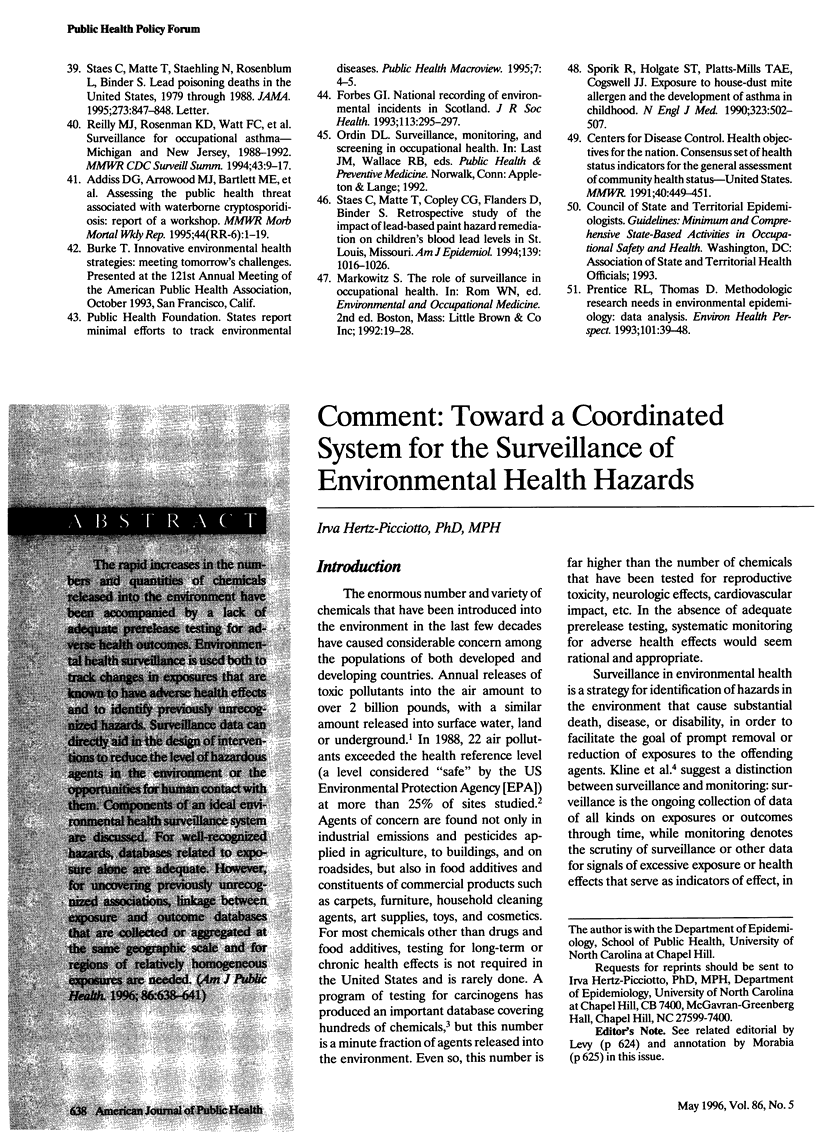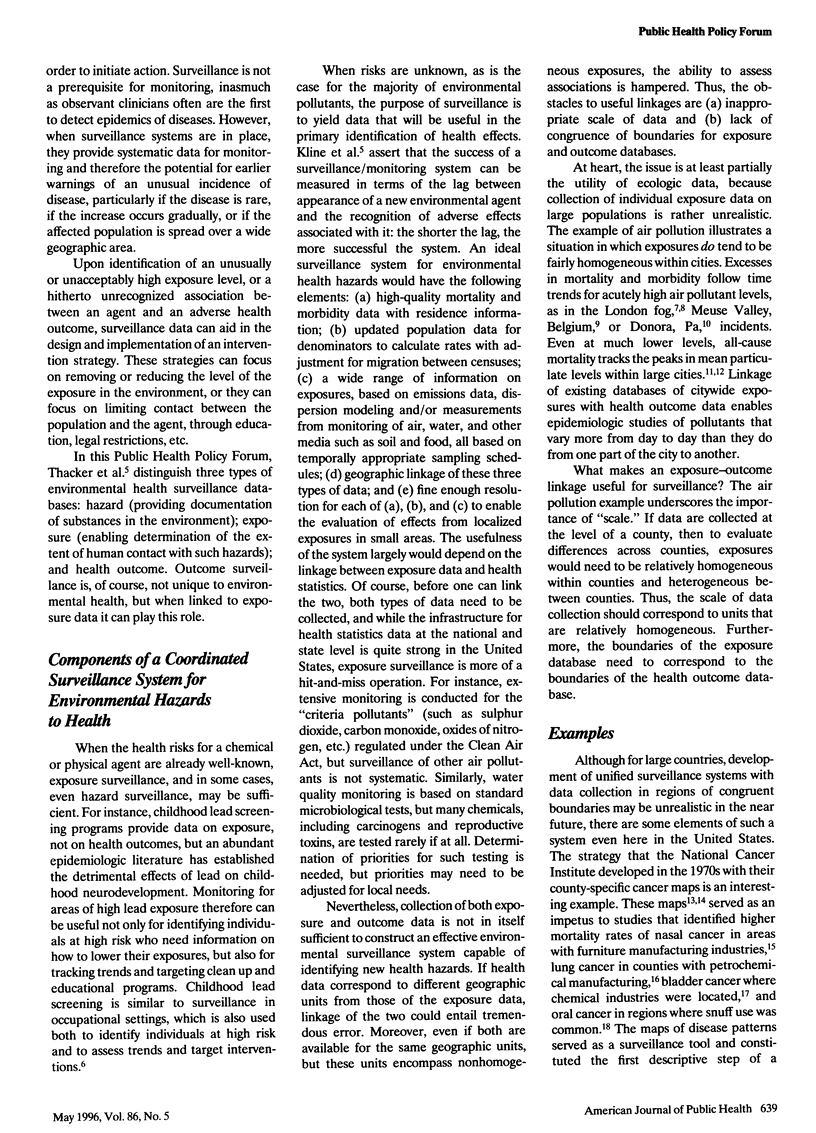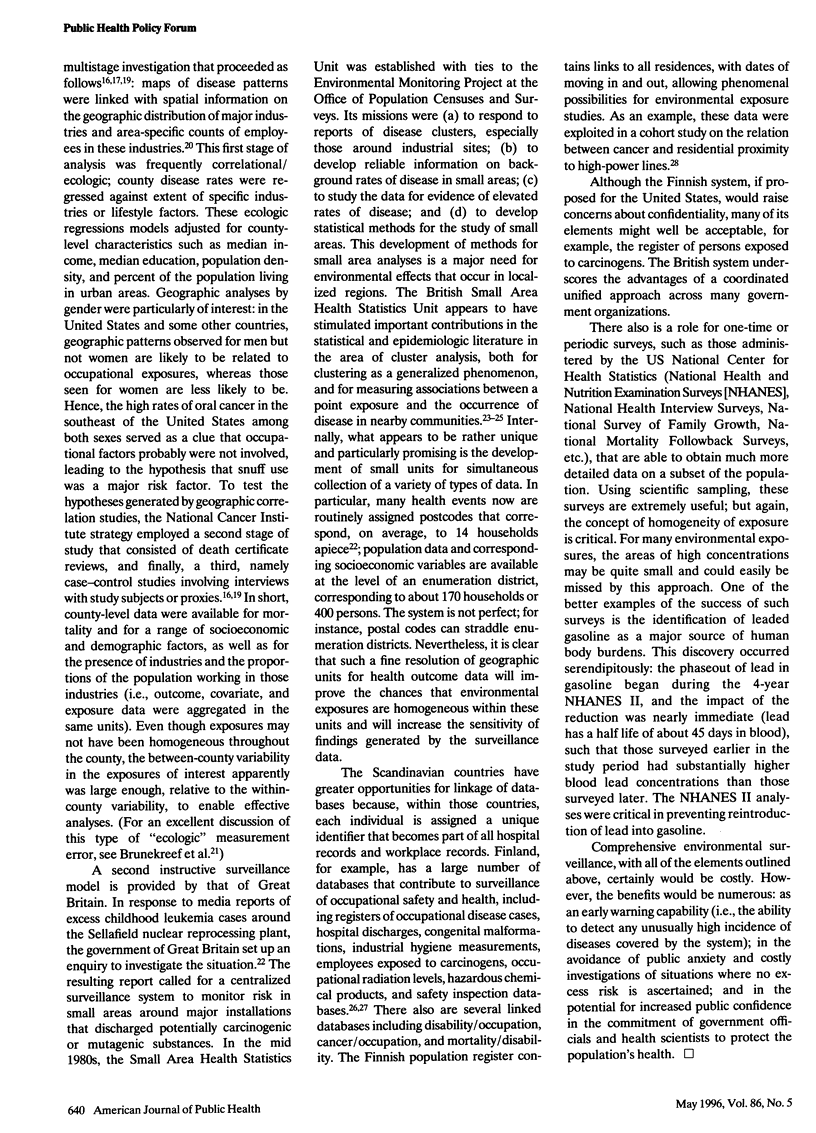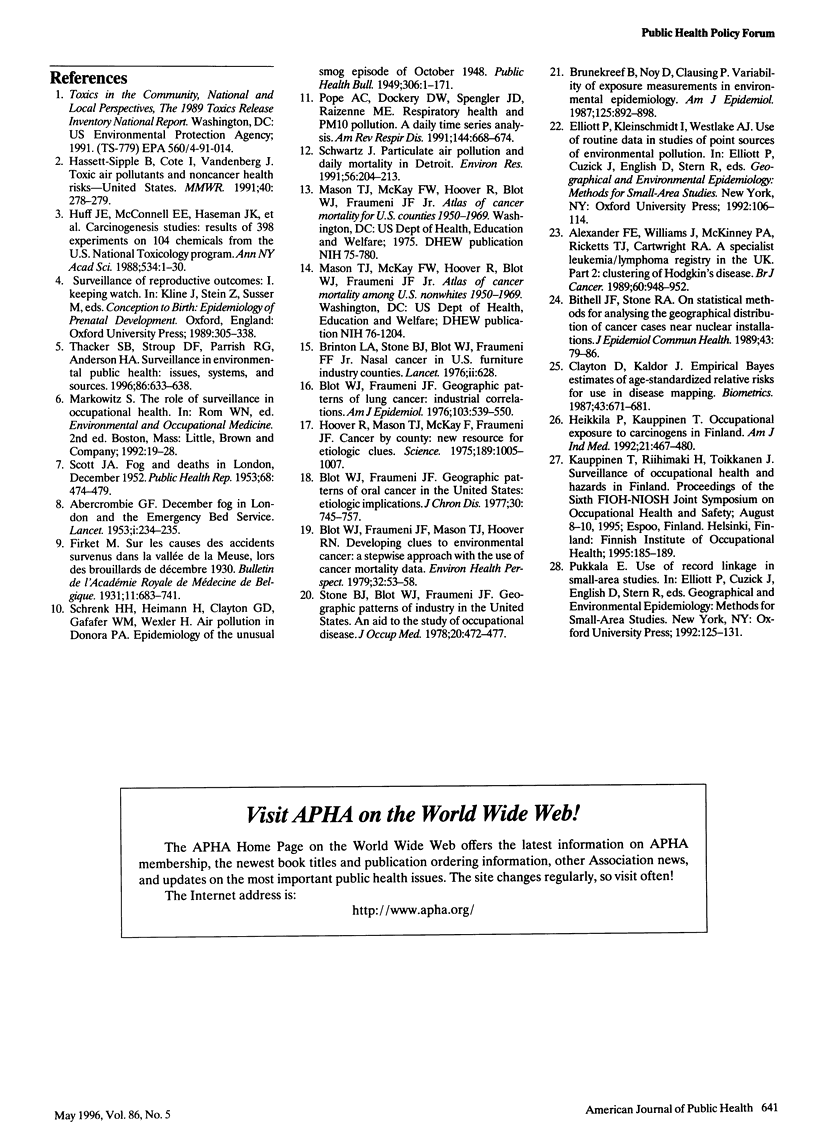Abstract
The rapid increases in the numbers and quantities of chemicals released into the environment have been accompanied by a lack of adequate prerelease testing for adverse health outcomes. Environmental health surveillance is used both to track changes in exposures that are known to have adverse health effects and to identify previously unrecognized hazards. Surveillance data can directly aid in the design of interventions to reduce the level of hazardous agents in the environment or the opportunities for human contact with them. Components of an ideal environmental health surveillance system are discussed. For well-recognized hazards, databases related to exposure alone are adequate. However, for uncovering previously unrecognized associations, linkage between exposure and outcome databases that are collected or aggregated at the same geographic scale and for regions of relatively homogeneous exposures are needed.
Full text
PDF



Selected References
These references are in PubMed. This may not be the complete list of references from this article.
- ABERCROMBIE G. F. December fog in London and the Emergency Bed Service. Lancet. 1953 Jan 31;1(6753):234–235. doi: 10.1016/s0140-6736(53)90905-2. [DOI] [PubMed] [Google Scholar]
- Alexander F. E., Williams J., McKinney P. A., Ricketts T. J., Cartwright R. A. A specialist leukaemia/lymphoma registry in the UK. Part 2: Clustering of Hodgkin's disease. Br J Cancer. 1989 Dec;60(6):948–952. doi: 10.1038/bjc.1989.396. [DOI] [PMC free article] [PubMed] [Google Scholar]
- Bithell J. F., Stone R. A. On statistical methods for analysing the geographical distribution of cancer cases near nuclear installations. J Epidemiol Community Health. 1989 Mar;43(1):79–85. doi: 10.1136/jech.43.1.79. [DOI] [PMC free article] [PubMed] [Google Scholar]
- Blot W. J., Fraumeni J. F., Jr Geographic patterns of lung cancer: industrial correlations. Am J Epidemiol. 1976 Jun;103(6):539–550. doi: 10.1093/oxfordjournals.aje.a112258. [DOI] [PubMed] [Google Scholar]
- Blot W. J., Fraumeni J. F., Jr Geographic patterns of oral cancer in the United States: etilogic implications. J Chronic Dis. 1977 Nov;30(11):745–757. doi: 10.1016/0021-9681(77)90003-0. [DOI] [PubMed] [Google Scholar]
- Blot W. J., Fraumeni J. F., Jr, Mason T. J., Hoover R. N. Developing clues to environmental cancer: a stepwise approach with the use of cancer mortality data. Environ Health Perspect. 1979 Oct;32:53–58. doi: 10.1289/ehp.793253. [DOI] [PMC free article] [PubMed] [Google Scholar]
- Brinton L. A., Stone B. J., Blot W. J., Fraumeni J. F., Jr Nasal cancer in U.S. furniture industry countries. Lancet. 1976 Sep 18;2(7986):628–628. doi: 10.1016/s0140-6736(76)90691-7. [DOI] [PubMed] [Google Scholar]
- Brunekreef B., Noy D., Clausing P. Variability of exposure measurements in environmental epidemiology. Am J Epidemiol. 1987 May;125(5):892–898. doi: 10.1093/oxfordjournals.aje.a114606. [DOI] [PubMed] [Google Scholar]
- Clayton D., Kaldor J. Empirical Bayes estimates of age-standardized relative risks for use in disease mapping. Biometrics. 1987 Sep;43(3):671–681. [PubMed] [Google Scholar]
- Heikkilä P., Kauppinen T. Occupational exposure to carcinogens in Finland. Am J Ind Med. 1992;21(4):467–480. doi: 10.1002/ajim.4700210403. [DOI] [PubMed] [Google Scholar]
- Hoover R., Mason T. J., McKay F. W., Fraumeni J. F., Jr Cancer by county: new resource for etiologic clues. Science. 1975 Sep 19;189(4207):1005–1007. doi: 10.1126/science.1220005. [DOI] [PubMed] [Google Scholar]
- Huff J. E., McConnell E. E., Haseman J. K., Boorman G. A., Eustis S. L., Schwetz B. A., Rao G. N., Jameson C. W., Hart L. G., Rall D. P. Carcinogenesis studies: results of 398 experiments on 104 chemicals from the U.S. National Toxicology Program. Ann N Y Acad Sci. 1988;534:1–30. doi: 10.1111/j.1749-6632.1988.tb30085.x. [DOI] [PubMed] [Google Scholar]
- Pope C. A., 3rd, Dockery D. W., Spengler J. D., Raizenne M. E. Respiratory health and PM10 pollution. A daily time series analysis. Am Rev Respir Dis. 1991 Sep;144(3 Pt 1):668–674. doi: 10.1164/ajrccm/144.3_Pt_1.668. [DOI] [PubMed] [Google Scholar]
- SCOTT J. A. Fog and deaths in London, December 1952. Public Health Rep. 1953 May;68(5):474–479. [PMC free article] [PubMed] [Google Scholar]
- Schwartz J. Particulate air pollution and daily mortality in Detroit. Environ Res. 1991 Dec;56(2):204–213. doi: 10.1016/s0013-9351(05)80009-x. [DOI] [PubMed] [Google Scholar]
- Stone B. J., Blot W. J., Fraumeni J. F., Jr Geographic patterns of industry in the United States. An aid to the study of occupational disease. J Occup Med. 1978 Jul;20(7):472–477. doi: 10.1097/00043764-197807000-00008. [DOI] [PubMed] [Google Scholar]
- Thacker S. B., Stroup D. F., Parrish R. G., Anderson H. A. Surveillance in environmental public health: issues, systems, and sources. Am J Public Health. 1996 May;86(5):633–638. doi: 10.2105/ajph.86.5.633. [DOI] [PMC free article] [PubMed] [Google Scholar]


